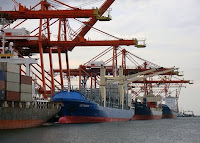Design-added-value vs labour-added-value
 Doy Santos aka The Cusp recently trumpetted in an article on ProPinoy.net how the Philippines "has emerged as a world leader in [the value of exports of high-tech manufactures], edging out Singapore, the former front-runner since 1996".
Doy Santos aka The Cusp recently trumpetted in an article on ProPinoy.net how the Philippines "has emerged as a world leader in [the value of exports of high-tech manufactures], edging out Singapore, the former front-runner since 1996".I pointed out in a comment on his article that...
Claiming we are "technology exporters" is like a stenographer making a claim to authoring a document that she merely typed out for his/her boss.
Specifically, much of what constitues the "value" of our exports of these goods can be deemed nothing more than labour-added-value. Our leg of the value chain of these exports involves factories that assembled materials that were pre-fabricated closer to their origins. Our workers implement production processes and follow assembly blueprints that were developed (read: designed) elsewhere.
In short, much of the design-added-value had already been input into the goods by the time they are landed as assembly kits on a Philippine port. The question, therefore, that Mr Santos needs to ask himself is this:
How much of the value of the export was added/created in the Philippines?
I elaborate further in another comment...
Say for example you export $100 worth of calculators, and $95 of that is accounted for by materials, handling, design, pre-assembly, and transport that happened before the kits for assembly arrived as an import at a Philippine port and hauled to the assembly plant in Cabuyao.
That means, the Philippine leg of the value chain contributed only $5 to the value of this export. The net added value of Pinoy enterprise is a small fraction of the total gross value of the export.
Looking to China for a bit of context, we find that awesome society moving in a different direction:
Now some of the most advanced research in this high-value, fast-growing field is being done in China -- instead of in the U.S. with American engineers.
While we cheer our role as an assembly outpost for electronic trinkets, China is positioning itself as a centre for design.
Pretty soon, we will be importing pre-fabricated kits designed in China as well.




Follow the link in his article of cherry-picked facts, and check out some of the other indicators. Of particular interest is the one that describes debt service as a percentage of exports. There's some other good ones, too, such as FDI, percent of paved roads, net migration, etc.
ReplyDelete